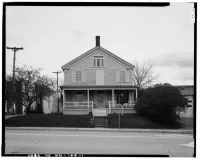Share what you know,
and discover more.
Share what you know,
and discover more.

-

- Marley Zielike
Alexander Faribault House, 12 Northeast First Ave Faribault, Rice County, MN
Alexander Faribault was a man of significance in the early history of Minnesota. As a fur trader with the American Fur Company, licensed by the U.S. Government to trade with the Indians in Indian Territory, he was one of the first "white" men to explore and settle in southern Minnesota. As a man of Indian heritage himself, his mother being half Dakota, married to a woman who was half Dakota, he was able to move comfortably among both white and Indian cultures. He acted as interpreter and negotiator in the Treaties of Mendota and Traverse des Sioux, which opened up a large part of Minnesota to white settlement in 1851. As the founder of the town of Faribault, he guided its early growth by recruiting settlers and by giving generously of land and money to build churches and schools. His home was an early gathering place and polling to organize Rice County took place upon his porch. He remained friends with the native Dakota people and sheltered several families on his land during and after the Sioux Uprising of 1862 when the sentiment of the state and county was openly hostile to Indians. When Alexander Faribault was old and impoverished, the town supported him and paid his funeral expenses in gratitude for his lifelong generosity and leadership. The house he built in 1853 is in the Greek Revival style typical of many of the earliest river front frame houses in Minnesota. It is thought to be the oldest wood frame house in southern Minnesota. Two stories tall, it must have been quite impressive in its early days surrounded by the Native Americans` tepees and the white settlers` log houses. Even today it is a spacious and comfortable house.
Alexander Faribault House, 12 Northeast First Ave Faribault, Rice County, MN
Alexander Faribault was a man of significance in the early history of Minnesota. As a fur trader with the American Fur Company, licensed by the U.S. Government to trade with the Indians in Indian Territory, he was one of the first "white" men to explore and settle in southern Minnesota. As a man of Indian heritage himself, his mother being half Dakota, married to a woman who was half Dakota, he was able to move comfortably among both white and Indian cultures. He acted as interpreter and negotiator in the Treaties of Mendota and Traverse des Sioux, which opened up a large part of Minnesota to white settlement in 1851. As the founder of the town of Faribault, he guided its early growth by recruiting settlers and by giving generously of land and money to build churches and schools. His home was an early gathering place and polling to organize Rice County took place upon his porch. He remained friends with the native Dakota people and sheltered several families on his land during and after the Sioux Uprising of 1862 when the sentiment of the state and county was openly hostile to Indians. When Alexander Faribault was old and impoverished, the town supported him and paid his funeral expenses in gratitude for his lifelong generosity and leadership. The house he built in 1853 is in the Greek Revival style typical of many of the earliest river front frame houses in Minnesota. It is thought to be the oldest wood frame house in southern Minnesota. Two stories tall, it must have been quite impressive in its early days surrounded by the Native Americans` tepees and the white settlers` log houses. Even today it is a spacious and comfortable house.
Alexander Faribault House, 12 Northeast First Ave Faribault, Rice County, MN
Alexander Faribault was a man of significance in the early history of Minnesota. As a fur trader with the American Fur Company, licensed by the U.S. Government to trade with the Indians in Indian Territory, he was one of the first "white" men to explore and settle in southern Minnesota. As a man of Indian heritage himself, his mother being half Dakota, married to a woman who was half Dakota, he was able to move comfortably among both white and Indian cultures. He acted as interpreter and negotiator in the Treaties of Mendota and Traverse des Sioux, which opened up a large part of Minnesota to white settlement in 1851. As the founder of the town of Faribault, he guided its early growth by recruiting settlers and by giving generously of land and money to build churches and schools. His home was an early gathering place and polling to organize Rice County took place upon his porch. He remained friends with the native Dakota people and sheltered several families on his land during and after the Sioux Uprising of 1862 when the sentiment of the state and county was openly hostile to Indians. When Alexander Faribault was old and impoverished, the town supported him and paid his funeral expenses in gratitude for his lifelong generosity and leadership. The house he built in 1853 is in the Greek Revival style typical of many of the earliest river front frame houses in Minnesota. It is thought to be the oldest wood frame house in southern Minnesota. Two stories tall, it must have been quite impressive in its early days surrounded by the Native Americans` tepees and the white settlers` log houses. Even today it is a spacious and comfortable house.Posted Date
Sep 27, 2021
Source Name
Library of Congress
Source Website
Delete Story
Are you sure you want to delete this story?










